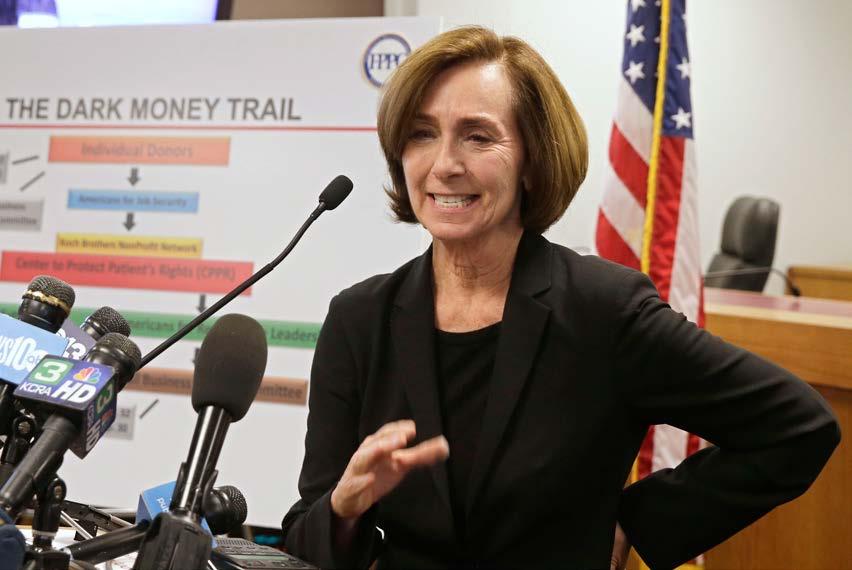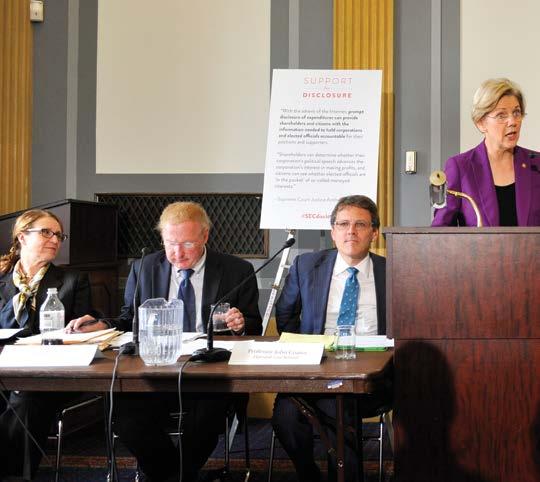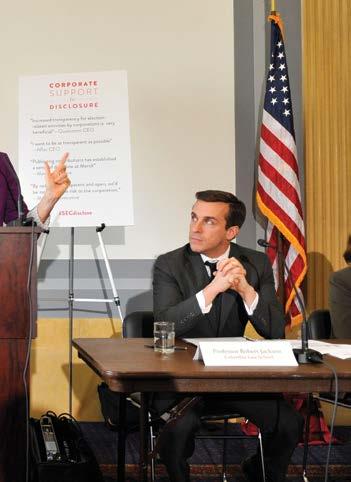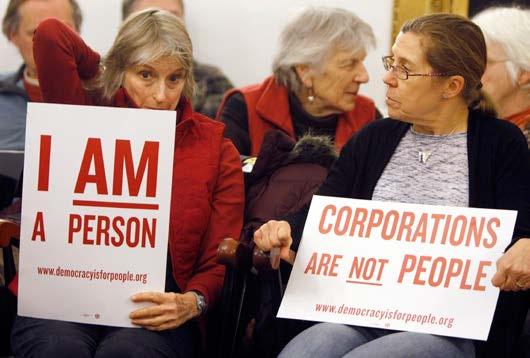
11 minute read
CAMPAIGN FINANCE
STATE CAMPAIGN FINANCE LAWS
by Jennifer Ginn
In the past, a casual observer might have equated court cases involving campaign finance law to summer thunderstorms. They popped up frequently, occasionally caused some brief concern about consequences and then quickly faded away.
Darrin Lim, conference co-chair of the nonprofit, nonpartisan Council on Governmental Ethics Laws and partner with the law firm Nielsen Merksamer in California, thinks the U.S. Supreme Court cases regarding campaign finance law in the past four years are a lot more serious than just a thunderstorm.
“Citizens United and McCutcheon are earthquakes in campaign finance,” Lim said. “The reason they’re earthquakes is they wake everyone up, they remind everyone that it’s important to be present and aware of the current landscape. The landscape has definitely changed as a result of these two Supreme Court decisions.”
A Changing Landscape
Paul S. Ryan, senior counsel to The Campaign Legal Center—a nonprofit, nonpartisan organization that offers analyses of issues dealing with campaign finance and elections, political communications and government ethics—said recent Supreme Court cases go back to regulations laid out in the Bipartisan Campaign Reform Act of 2002, otherwise known as the McCain-Feingold Act.
The bill tackled what is known as electioneering communications, which corporations and unions were banned from funding. Courts had been using the expressed advocacy test. That test raised the question: Did the ad tell viewers to vote for or against a particular candidate?
“It was easy to get around,” Ryan said. “You could simply refrain from including language in your political ad along the lines of ‘vote for’ or ‘vote against’ and, instead, simply run ads that said, ‘Candidate Smith beats his wife. Call candidate Smith and tell him why he shouldn’t be a wife beater.’”
Ryan said the McCain-Feingold Act forbade corporations or unions from using their general fund treasury to pay for electioneering ads. The bill also said anybody paying for these types of electioneering communications had to file a disclosure report if they spent more than $10,000; the disclosure includes the name and address of all contributors of $1,000 or more.
The new law was challenged almost immediately. The Supreme Court in 2003, in McConnell v. FEC, upheld all of the bill’s provisions. Ryan said things started changing in a 2007 Supreme Court case—Wisconsin Right to Life v. FEC—when the definition of what constitutes an electioneering communication began to loosen.
“I think all the attorneys paying attention to that decision understood that Chief Justice (John) Roberts, in his eyes, all these restrictions on corporations paying for these ads were vulnerable to constitutional challenge,” Ryan said. “We kind of saw the writing on the wall in 2007.”
Then in 2010, the Supreme Court in Citizens United v. FEC struck down much of the rest of McCain-Feingold.
“The court in Citizens United held that corporations and unions cannot be restricted in their political spending,” Ryan said. “They have a First Amendment right, they are persons under the First Amendment and they have the right to make unlimited political expenditures.”
Another case from this year—McCutcheon v. FEC—sent smaller shock waves through the campaign finance world. The Supreme Court banned aggregate spending limits on the total amount a person can donate in any election cycle. But more importantly, the ruling said government can only regulate action that would lead to “quid pro quo” corruption.
Lisa Soronen, executive director of the State and Local Legal Center, said the McCutcheon case was so surprising because it overturned previous court rulings that OK’d governmental
regulation to protect against even the appearance of corruption.
“The McCutcheon case has been cited too because the court overturned precedent,” Soronen said. “McCutcheon represents a sort of more unapologetic overturning of precedent and that’s just not what the court really does in general. It either doesn’t overturn precedent or it doesn’t do it so explicitly. When you see your average American taking note and you see precedent sort of being thrown out the window, you know something is happening.”
DISCLOSURE WARRANTED
SACRAMENTO, CALIF.—Ann Ravel, chairwoman of the California Fair Political Practices Commission, discussed the $1 million fine, the largest in its history, levied against two political action committees for campaign reporting violations, during a news conference in October 2013. New state laws are concentrating on disclosure of campaign contributions.
© AP Photo/Rich Pedroncelli
hot topic
Major Federal, U.S. Supreme Court Action on Campaign Finance Laws
}Bipartisan Campaign Reform Act of 2002: Also known as the McCain-Feingold Act, this law made major changes to campaign finance law.
The law:
» Prohibited national parties from raising or spending nonfederal—or soft—money;
» Prohibited corporations and labor organizations from sponsoring electioneering communications, meaning ads that clearly identify a candidate for federal office; and
» Required disclosure of donors of $1,000 or more to any organization that paid an aggregate of $10,000 or more in electioneering communications. } McConnell v. FEC: Decided by the U.S. Supreme
Court in 2003, this case upheld several provisions of the McCain-Feingold Act. The court ruled that bans on unrestricted soft money, regulations on electioneering communications and the definition of electioneering communications as ads occurring within 60 days of a general election or 30 days of primary were all constitutional. } Wisconsin Right to Life v. FEC: Decided in 2007, the Supreme Court ruled that the restriction banning the use of corporate treasury funds for electioneering communications in the 60 days prior to a general election was unconstitutional for issue ads, meaning ads that don’t expressly endorse a particular candidate. } Citizens United v. FEC: Decided by the Supreme
Court in 2010, this case declared additional parts of the McCain-Feingold Act were unconstitutional. Citizens United expanded the First
Amendment right to freedom of speech to corporations and declared that banning corporate expenditures expressly advocating the election or defeat of a candidate was unconstitutional as long as the spending was done independently of the candidate. } McCutcheon v. FEC: This 2014 decision by the
Supreme Court struck down aggregate spending limits that limited how much a person can donate during a two-year period to all federal candidates, keeping in place the limits of how much a person could give to one particular candidate. The ruling also marked a change for the court about when the government may regulate contributions. In previous rulings, the court held that regulating campaign contributions may be done to protect “against corruption or the appearance of corruption.” Chief Justice John
Roberts wrote in this case that Congress may only target “quid pro quo corruption.”
© CORBIS/Jay Mallin

Lim, of the Council on Governmental Ethics Laws, said Citizens United and McCutcheon have pumped more money than ever into political campaigns and that is changing many things in campaign finance law.
“What is important with the Supreme Court decisions that have come out, Citizens United and McCutcheon, they may deal directly with federal law, but what they do indirectly is to potentially reshape how we think about money and politics,” Lim said. “That’s what’s been so interesting over the last few years is these earthquakes have forced all of us to reassess how we think money and politics are regulated.”
Disclosure on the Upswing
With more money being funneled into campaigns, Ryan and Lim said states are concentrating on disclosure. Ryan said after Citizens United allowed corporations and unions to fund electioneering ads, many states had some complex new questions to consider.
“Many states’ laws did not accommodate or did not require effective disclosure by these groups because, for decades, roughly half of the states banned corporate expenditures,” Ryan said. “The question we’ve been hearing states grappling with over the past four years or so post Citizens United is what should we be requiring corporate entities, including nonprofits, to disclose, what does the Constitution permit us to require them to disclose.”
Lim said the old idea of disclosure—requiring candidates to fill out paper forms, which are linked on the secretary of state’s website—is beginning to fade.
“I think the trend is for regulators to do more with that data,” he said, “to make the information more interactive, to make the information more powerful and to make the information more useful to the voter. Voters are expecting to go to a place where they can really analyze the information without having to thumb through page after page of data.”
Hawaii Gets Visual
That’s exactly where the Hawaii Campaign Spending Commission is going. Hawaii, which has been requiring electronic disclosure forms from all candidates since 2008, launched a new online tool last year that allows people to view pie charts about who has been giving candidates money, whether that money was from in-state or out-of-state sources and how it is being spent.
“The idea is to see if this candidate is aligned with their (the voter’s) interests,” said Kristin Izumi-Nitao, executive director of the state’s spending commission. “It’s much easier to do so in a colorful pie

CITIZENS UNITED DECISION
U.S. Sen. Elizabeth Warren, D-Mass., at left, called on the Securities and Exchange Commission to institute rules that would require corporations to disclose their political contributions. Warren spoke at a briefing sponsored by the Corporate Reform Coalition, a group formed in response to the Supreme Court’s “Citizens United” decision lifting limits on corporate political spending. Darrin Lim, conference co-chair of the nonprofit, nonpartisan Council on Governmental Ethics Laws, called the decision and another similar ruling “earthquakes in campaign finance” because the ruling woke everyone up with regard to campaign finance laws. Below, people held signs in 2012 during a gathering on the anniversary of the Citizens United decision in Montpelier, Vt. Several Vermont communities chimed in on a proposal to pass a Constitutional amendment to clarify that corporations do not have the same rights as human beings.
chart or graph rather than in spreadsheets. We thought there was huge value in that.”
Although the original tool gave information only about candidates, a new one will be online before November’s election that lets residents see graphics about political action committees, what Hawaii calls noncandidate committees.
“Noncandidate committees are going to show what races they’re involved in: Was it a mayoral race, a gubernatorial, a council race or a legislative race?” she said. “You can break it down. Is it a Democrat race, a Republican race or are they supporting a libertarian? … It’s the same goal of sorting through the data filed by the committee so that the viewer can see it more readily.”
Izumi-Nitao believes it’s vital for states to keep improving how disclosure data is used.
“I think it’s huge,” she said. “We want people to engage, we want them to be informed and it’s, of course, in the spirit of transparency. That’s what we’re all about. … If we’re collecting data, we want to make sure people get to see the data.”
Letting the SUN Shine In
In California, the Fair Political Practices Commission’s efforts have centered around shining a light on what has come to be known as dark money. The term was coined after the 2012 election when $15 million poured into California from outside groups to fight for one proposition on the ballot and against an
© AP Photo/Toby Talbot

other. The money was funneled through three different political action committees and the people who contributed the money originally still have not been publicly identified.
Senate Bill 27, which was passed earlier this year, requires state ballot measures and state candidate committees that raise $1 million or more for an election to disclose lists of the committee’s top 10 contributors; that information will be available on California’s Fair Political Practices Commission’s website. The legislation also closes a loophole that allowed nonprofits with no history of political spending to make a one-time donation without disclosing the identities of the donors.
“SB 27 gets at the heart of further disclosure and allows people to see who’s donating to campaigns when it matters most, which is before the election rather than after,” said Jay Wierenga, communications director for the Fair Political Practices Commission.
But the potential for dark money, increasingly, isn’t just a California issue. In a hotly contested U.S. Senate race in Alaska, for instance, $20 million worth of ads had already been bought five months before the November election, funded primarily by out-of-state super PACs, according to a June article in The New York Times.
Alaskans are not happy so much out-ofstate money is pouring in to try to get the attention of the state’s 490,000 registered voters. “It’s not Karl Rove’s seat. It’s not Harry Reid’s seat. It’s our seat,” Alaska Lt. Gov. Mead Treadwell said in The New York Times article.
That concern about the possible taint of dark money led to the establishment last year of the SUN Center, which is run out of the California commission’s office. The center is comprised of governmental ethics regulators from 12 states and two cities that hold a conference call every two months to discuss best practices for enforcement and innovative legislation concerning dark money. The center also has a website and a Twitter account to provide daily updates about campaign finance.
Wierenga believes the SUN Center has a lot of potential for growth because disclosure laws are vital to the political process.
“It comes to the fundamental point of giving the voters as much information as possible and that includes where campaign money is coming from,” he said. “That information obviously will lead people to make decisions and these are decisions that are important. The voting process is obviously fundamental to our (political) system.” SEPT/OCT 2014 | CAPITOL IDEAS 29


